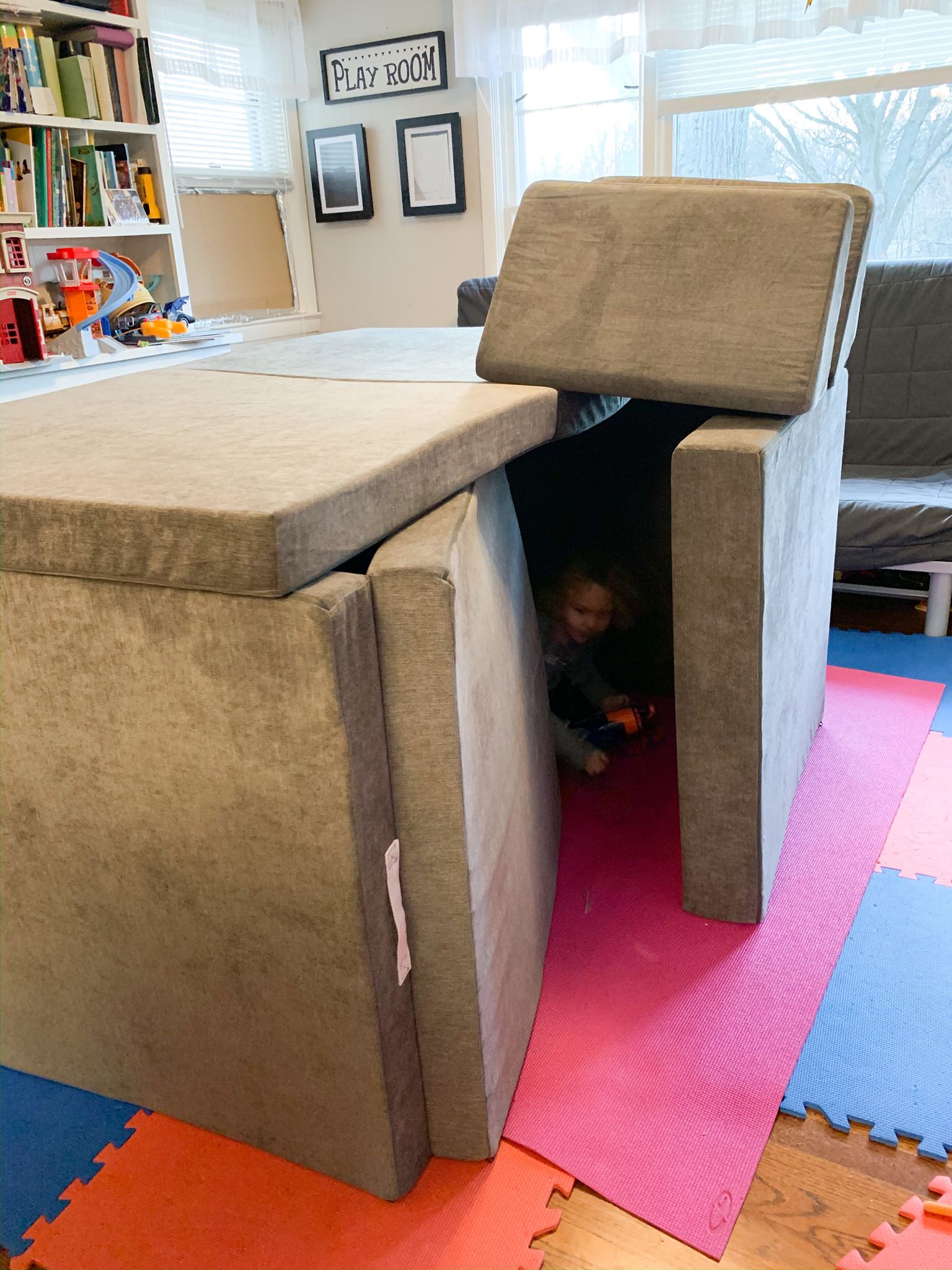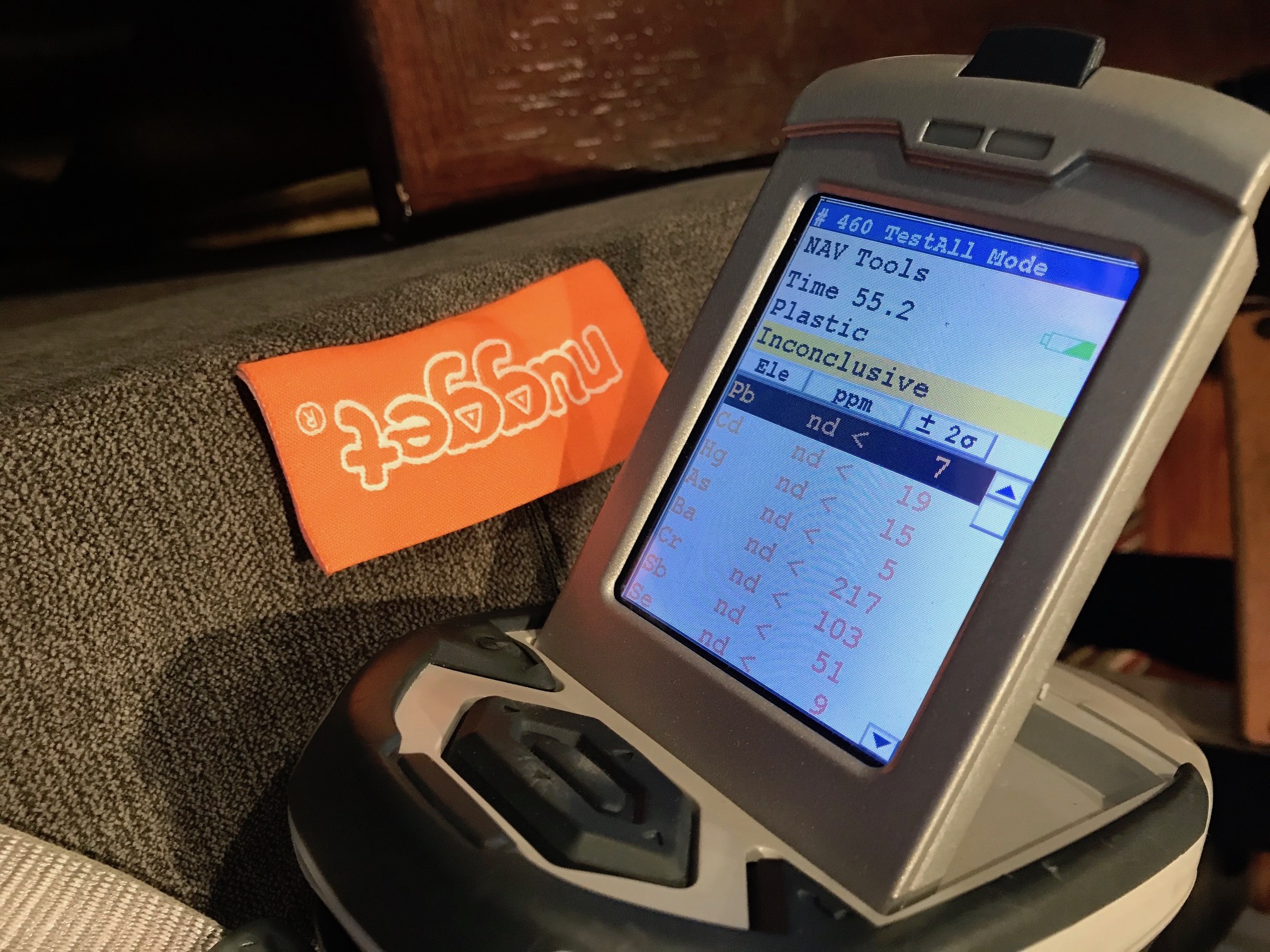Independent test shows Nugget Comfort couch is negative for Lead, Cadmium, Mercury & (most surprisingly) Antimony!

XRF testing of a Nugget Comfort couch
In one of my recent cross-country trips I had the opportunity to test a Nugget Comfort couch using high-precision XRF technology (the gray Nugget couch pictured in the photo above). XRF technology (using instrumentation and software specifically designed to test consumer goods for the presence of metals down to single digit parts per million) is the same method of testing used by the Consumer Product Safety Commission to test toys (and other items intended for use by children) for the presence of heavy metal toxicants including Lead, Cadmium, Arsenic and Mercury. You can read more about the testing that I do and the instrumentation that I use at this link.
Test results for all of the testing reported on this page are accurate, science-based, and replicable. Each component of the Nugget couch pictured was tested multiple times, to confirm the results (including exterior fabric, interior foam, and zipper.) Test results reported below are one set of test results [all test results of the fabric and foam had similar readings; the zipper was also negative for heavy metal toxicants, but I did not record the full set of the readings for the zipper]. While I only tested this one gray couch, based on the nature of these products, I would expect other colors would have similar test results.
New to this page? Who is Tamara?
Tamara Rubin is an independent advocate for consumer goods safety, and she is also a mother of Lead-poisoned children. She began testing consumer goods for toxicants in 2009 and was the parent-advocate responsible for finding Lead in the popular fidget spinner toys in 2017. She uses high-precision XRF testing (a scientific method used by the Consumer Product Safety Commission) to test consumer goods for contaminants including Lead, Cadmium, Mercury and Arsenic.
Continue reading below the image
Here are the exact XRF test results for the gray Nugget couch pictured above:
- Lead (Pb): Negative / Non-Detect
- Cadmium (Cd): Negative / Non-Detect
- Mercury (Hg): Negative / Non-Detect
- Arsenic (As): Negative / Non-Detect
- Barium (Ba): Negative / Non-Detect
- Chromium (Cr): Negative / Non-Detect
- Antimony (Sb): Negative / Non-Detect
- Selenium (Se): Negative / Non-Detect
Why are these test results unusual?
While it is not unusual to find modern fabric items that are negative for Lead, Cadmium, and Mercury it is incredibly unusual to find modern fabric (and especially stuffed / upholstered) items (including chairs, quilts, mattresses, couches and dolls) to also test negative for Antimony. The majority of conventional [not Organic] fabric stuffed items sold today – or in recent years – that I have tested have been positive for at least some amount of Antimony (usually in the range of 100 to 300 parts per million [ppm]).
Is Antimony a problem?
The International Antimony Association asserts that persistent low-level exposure to Antimony in our fabric goods (and plastic food containers, like peanut butter jars) has no potential impact on human health, yet more and more often I have readers informing me that a heavy metals analysis [of their blood, urine, or hair] has come back positive for a concerning level of Antimony (sometimes at fairly high levels.)
Antimony is known to cause cancer in rats, and to cause breathing issues in humans. Industrial exposure to Antimony (by workers exposed to the substance daily) is known to be potentially very damaging to human health. Finding a popular, conventional (not-made-of-organic-materials) fabric upholstered (or “stuffed”) item that is negative for Antimony (in 2020) is actually very difficult. In my opinion the “trace” levels of Antimony found in so many household goods today is concerning — as I do not believe enough study has been done (by independent research bodies) to determine the health impacts of chronic daily exposure to trace levels found in so many common objects in our homes.
Perhaps of interest to many of my readers:
Don’t panic— your stuffed dolls, quilts and furniture from the 1980s and earlier are, however often negative for Antimony in the stuffing [but can be positive for Lead in metal, ceramic or painted components – like eyeballs, buttons, hands and other trim]. It is only more recent (past 30 years – c. 1990 to 2020) plastic-based fabrics and fillers that are testing positive for “trace” levels of Antimony. I do not yet have enough data points to assert an exact year (for example “1989″ or “1992”, etc.) that this transition was made; I have just found that most (if not all) pre-1990 examples of stuffed fabric items I have tested have been negative for Antimony.
In conclusion….
I’m jealous of you younger moms (with smaller kids!), because you will (hopefully) have the opportunity to purchase one of these for your kids! I have so many fond memories of making forts with my sister when I was little (45+ years ago!) and would have definitely bought these Nugget couches for my children when they were younger, had I known about them (had they existed then) – to encourage the same type of creative play! I’m not exactly sure how long these have been in production – but I get the sense that they are fairly new (and very popular!) phenomenon.
Unfortunately, this product has been sold out since the Zombie Apocalypse, but here’s the link to their site for those who are curious. I will probably buy a couple of these when I end up with grandkids to entertain at home, someday. In fact – even though my youngest son is almost 12 years old, I think he would really enjoy one of these (he has a mental illness diagnosis and sensory issues) – so I am going to keep checking their website to see when they are available next, in the hopes that the timing coincides with some space being available in the boys’ bedroom (and in my budget) for a fun piece of furniture like this! Any non-toxic options that encourage creative play in our home are always welcome!
Some additional reading for those interested in this post:
- Posts about bedding with Antimony
- Posts about modern stuffed animals with Antimony
- Posts about vintage stuffed dolls
- More posts about furniture
Thank you for reading and for sharing my posts.
As always, please let me know if you have an questions.
Tamara Rubin
#LeadSafeMama

Never Miss an Important Article Again!
Join our Email List




I visited the Nugget website after reading this blog post, and it looks like something I’d get as a gift for people who have young children at home. I like that the cover can be thrown into the washing machine. I don’t have a sofa but I’d like to buy one in the future. The type if sofa I’d want is one that has very wide, flat, padded arms so that I can balance a heavy textbook and glass of water on it and not worry about it falling into the floor. I want to study for hours and hours without my elbow hurting from digging into a wooden armrest, or one that just has a very thin layer of fabric covering the armrests. I’d want the backrest to have a flat top that is slightly squishy and wide, just like the armrests, in case I want to switch position while studying to avoid ache in my body from keeping in the same position for too long. That way I can put textbooks and glasses of water on the back of the sofa, too. I have never seen a sofa like this that ALSO has the ability to recline and has a foot rest that pops out, like a La-Z-Boy recliner. I haven’t seen the tworld typed of sofas combined into one. I’be seen multi-seat sofas that have reclining backs and pop-out footrests, but the arms are overstuffed and poofy; same with the back. I do like that they have built-in cup holders, but then again that might be uncomfortable for my elbow or forearm. If you ever test a sofa like this, let me know.
K! Will do. Thanks for commenting Meg!
Tamara
Just curious, does Nugget use flame retardants, scotch guarding or formaldehyde releasing glues?
It’s so difficult to find truly nontoxic furniture.
Oh this is so exciting to read!! I just learned about the Nugget today and immediately wanted to know how toxic the materials were. I’m thrilled that it’s antimony free! Definitely going on my wish list and my daughter takes apart our coach every day and who really knows what’s in it…
How about the voc’s from the polyurethane? Considering it but for that…. thanks for your article and work on this!
Thanks for the awesome info! I’m curious about another play couch–the Figgy. I’d love to know if there’s anything to worry about in that one!
has the yourigmai kids dupe from costco been tested at all Tamara?